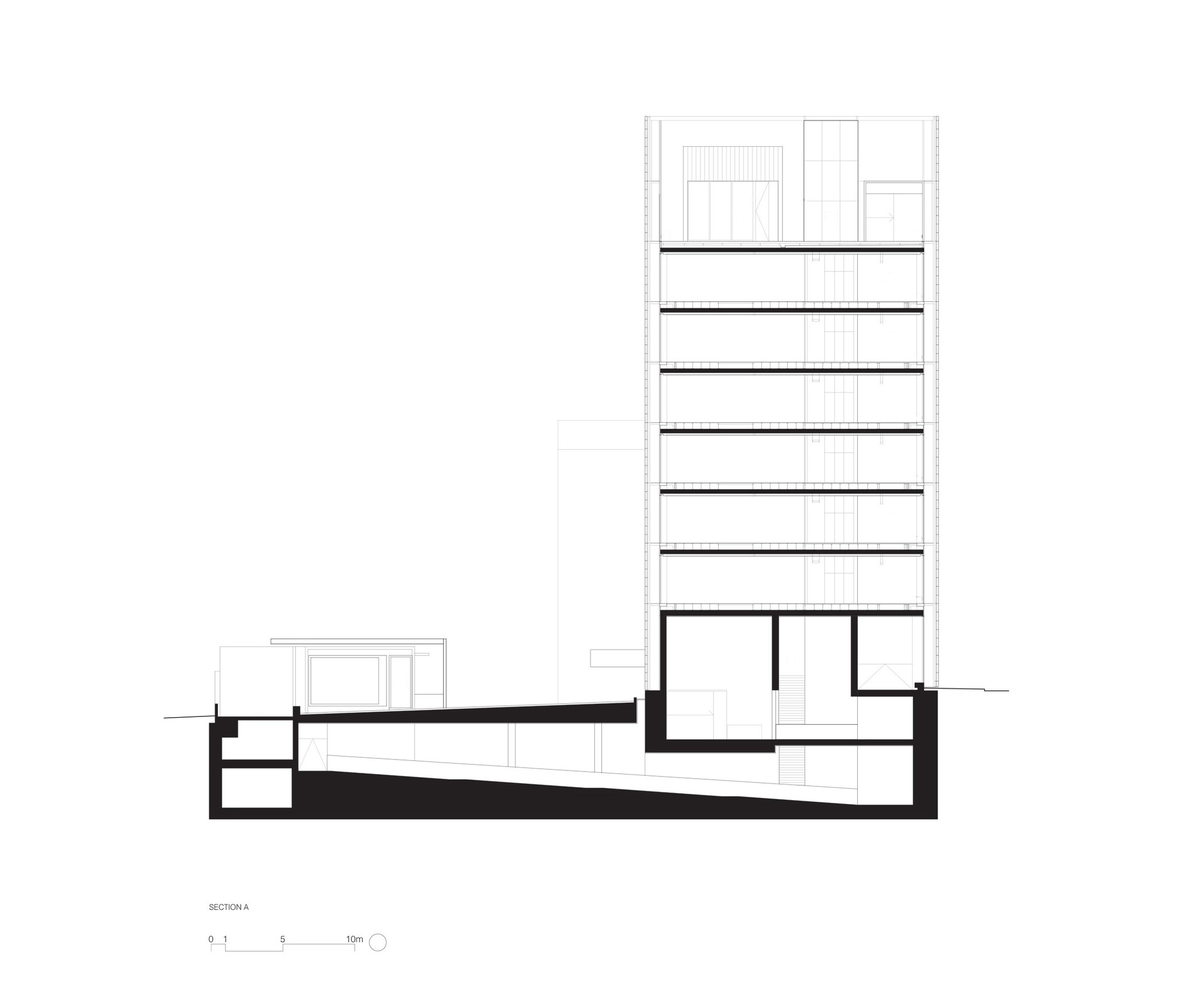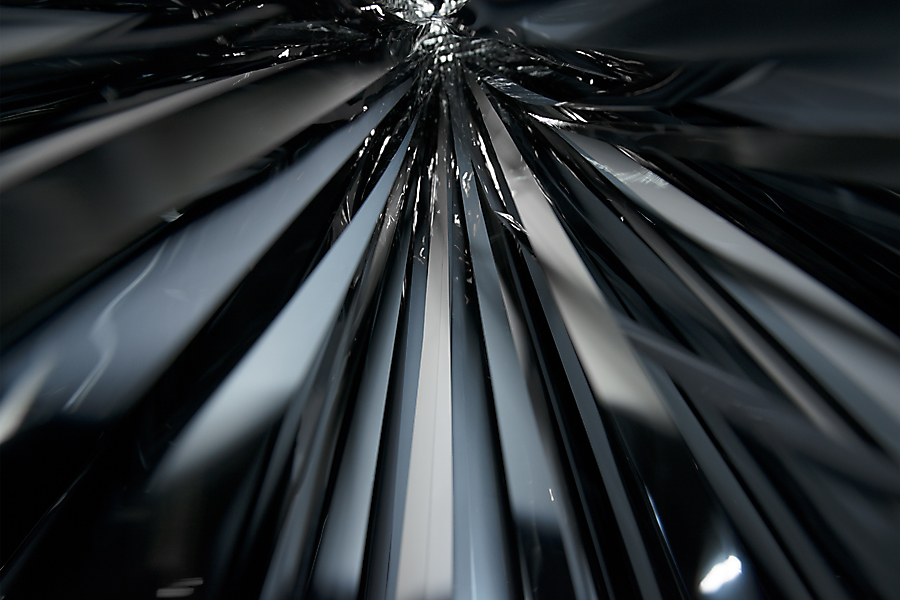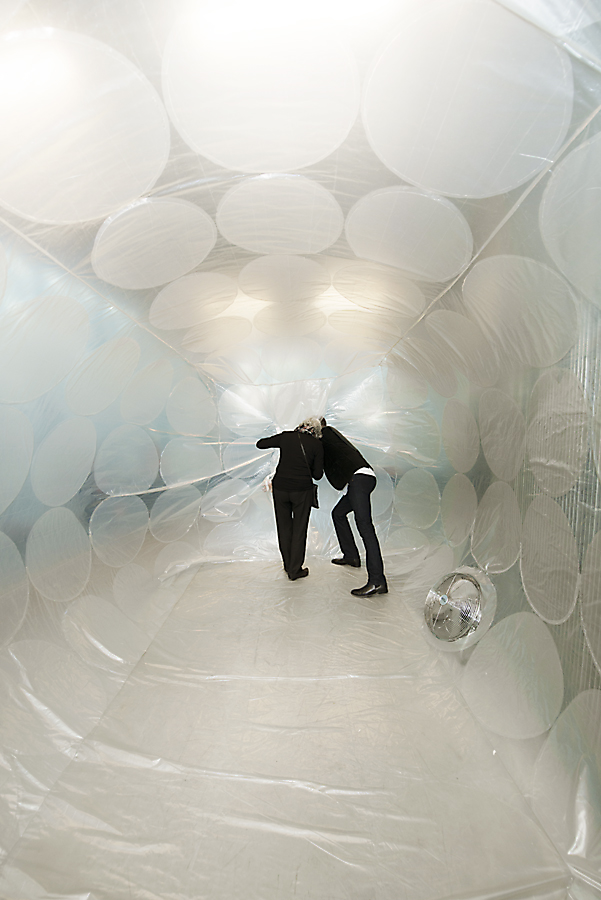The RMIT Design Hub opened in late 2012. It is a ten-storey building of relentlessly patterned and highly repetitive spaces with a publicly accessible series of gallery spaces sitting in close proximity to open-plan design research studios and offices. Each main floor of the building is nearly identical. New or occasional users of the building frequently get lost and cannot find their way into or out of particular spaces – most obvious at exhibition openings and days when the building is open to the public. Even after years of regularly frequenting the building, we still need to double-check that we are where we expected to be. It was against this background of unsettlingly rational order that a subtler process of getting to know the building occurred.
In order to prompt an exploratory engagement with the Design Hub, our colleague Pia Ednie-Brown organised a workshop called Building Movements (2013). This involved a series of performative actions to think through the building’s affordances, and the challenges and questions it posed to its inhabitants. Pia proposed that we might “also challenge the building by posing questions of our own – entering into an active dialogue” with it.
We approached the Design Hub as a collaborator, seeing it as a building that we were entering a dialogue with and which we wanted to ask questions of. Where are the liminal spaces in this seemingly very legible building? How can these be opened up? What new ways of understanding the building can be brought about through engaging in these spaces?
We also wanted to ask questions about spatial certainty; given that the building’s reliance on repetition pushed this idea to an extreme point where things were so controlled and contained that they ceased to provide certainty, we sought instead to question any sense of precise location. Initially, our focus was on questioning one’s sense of certainty: How could the cognitively backgrounded task of moving through space be brought into the foreground of conscious thought? To address these questions we chose materials based on their potentials to interact with the building’s existing materials and rhythms and created projects that tried to work around the regulatory systems that were imposed and overlaid on the building.
We started a process of examining the building’s design, searching for seams or thresholds, locations where we could intervene. We explored every space we had access to in the building, walked all the stairwells, used the service elevator and studied air movement in the building. Through these exploratory processes we developed a richer understanding of the building as comprised of material and infrastructural systems, overlaid with legal and bureaucratic processes, such as accessibility and public liability. As a result, we came to focus on the elevator as a threshold or seam between systems into which we could intervene. The elevator offered a kind of non-site, an in-between zone in the building, a threshold in the way that crossing through a doorway is a threshold. Rather than operating as a cognitive phenomenon of the separation between spaces, the threshold of the elevator offered a time-based experience. This actual space that one could inhabit is a threshold as it functions as this separation between the spaces one wants to move between. Extending this through our projects afforded the possibility of parsing out the relations at play in the interactions with the materials and forms of the building.
Working with colleagues and a team of students, we resolved and built a series of installation projects that directly adjoined the elevator doors on different levels of the Design Hub. A back-and-forth dialogue arose between us, the students, our projects and the spatial and material qualities of the architectural environment.
The first project to be realised was a dense field of black, glossy, lightweight threads which, on exiting the elevator, immersed one’s head and shoulders. We worked collectively to mass-produce the 4,200 lengths needed to create the rectilinear volume of the project. This volume was equal to that of the elevator interior, but tipped onto its side. The dimensions of the elevator provided a template for our project, and rotating and transposing this volume allowed for the spaces of project and building to come into dialogue.
The highly repetitive, linear nature of the threads echoed the building’s metal mesh interior linings, but with a sense of shimmering softness. Once hung, the threads moved in relation to the slightest movement of air. Collisions of strands created a delicate but enveloping aural field. This sound field reinforced the project’s mesmeric and claustrophobic qualities – as people exited the elevator and moved through the field, the threads were drawn towards their bodies, sometimes suctioned up against their noses and mouths as they inhaled, sometimes pushed away by exhalation and other air movements. In contrast to the inert materials that lined the building, the threads assumed the material language of the building while also shifting them into a more dynamic mode of encounter.
Video of Bhubble
As the elevator arrives at this floor and the doors open, the Bhubble begins to deflate. The pressurised air within the Bhubble interacts with the air of the elevator, and a balancing of pressures takes place. As the elevator doors close, the Bhubble begins to inflate again.
Buildings deploy huge quantities of technical and energetic resources in their attempt to create a predictable interior climate. But these interior climates are always changing; doors open, people breathe in and out, elevators move volumes of air from darkened basements to sun-filled atriums. A building interior is a sort of micro-climate, full of uncertainties introduced across its thresholds. Addressing this infrastructural material conversation, a second project also engaged with the air movement within the Design Hub, in this case an expression of rhythmic air movement on the scale of the building. A pressurised, inflatable interior cyclically contracted and expanded as its adjoining elevator doors opened and closed. The slow processes of deflation and re-inflation mimicked the rhythms of human breathing. We nicknamed the project Bhubble – a title that playfully encapsulated both the Design Hub and the project’s air-filled membrane. Bhubble was a space contingent on the materiality of air pressure and made this dependence visible. Stepping out of the elevator was to step into a space undergoing a slow-motion collapse. The project caused unsuspecting elevator users to move into a space of uncertainty, tentatively stepping into a space that gradually reasserted its very evident metastability only once the elevator doors had cut off any other course of action. The thin pliable plastic sheeting that made up this architectural addition made apparent the material conversations between air and architecture taking place within the Design Hub's inflexible grids of steel, concrete and glass.
In the process of designing and making Bhubble, Olivia Hamilton and two of the students realised that the dimensions of the sheet material would constrain the size of the ‘bubble’ we could produce, making it difficult for visitors to stand up inside it. Adding a join in the material would upset the seamless sense of space we hoped to create, and so we discussed strategies to conceal it. We decided the best way was to hide it among other joins and express these joins as a decorative feature. Given Bhubble’s translucence, we looked to the building’s exterior façade for an answer. Immediately, the suggestion arose to copy the translucent glass disc forms as the surface patterning for our inflatable structure. We realised that the circular signboards next to the elevator were the same exact dimensions as the sand-blasted glass circles of the exterior. Removing the signboard, we used it as a cutting guide for our plastic circles. In this moment, the material and geometric language of the building pressed its way explicitly into our project, interjecting itself into discussion and providing a template which allowed us to move the project forward together, while more closely integrating our projects in relation to the building.
A third project engaged materially with the disorientating and eye-straining effects created by prolonged periods of time in the Design Hub’s interiors, lined as they are with gridded metal mesh and arrays of circular cut-outs, and amplified by dramatic patternings of light and shadow streaming through the façade. These optical qualities were extended in an installation that overlaid a series of perforated metal layers and insisted on a building user’s physical participation.
Any straightforward exit from the elevator was blocked by a perforated metal box the same dimensions as the elevator interior. A circular label identical to those found throughout the rest of the building simply read ‘Push’. When this box was moved aside, a narrow exit corridor opened up, revealing that the box was housed inside a second larger perforated metal box. This physical relationship inverted the passive-user/active-building dynamic present within the elevator interior, and the motion of these perforated screens created a series of dazzling and disorientating moiré effects, which in turn were overlaid on the gridded circles of the building facade. The moiré emerged from a reconfiguration of the building’s patternings, inducing a sense of vertigo.
This reconfiguration came from a repetition of the materials and patterns of the Design Hub. The interior of the elevator is lined with this same perforated stainless metal sheeting, and the perforations are a micro-scale repetition of the sand-blasted glass circles that sheath the exterior of the building. Through repetition and movement, the disorientation already present in the architectural environment was amplified, the installation restating more loudly and clearly that which was uttered by the building.
Each in their own way, these projects exaggerated the building’s environmental effects in ways such that they ceased to provide a sense of spatial certainty. The uncertain situations set up by the larger project required bodily participation (through breath, movement and physical exertion) in order to navigate and make sense of what was going on. The interplay between the building and our installations can be thought of as a conversation, where the projects enter into a dialogue with the material, spatial, and infrastructural languages of the building and ‘speak back’ to it – sometimes in a spirit of friendly like-mindedness and at other times generating discord and disagreement.
Engaging a building in conversation by means of creative projects can be productively understood through the practice of ‘rhythmanalysis’. This is Henri Lefebvre’s term for an approach to nonverbal interaction that is both qualitative and analytical. Rhythmanalysis integrates an inwardly directed attention to bodily rhythms (beginning with heartbeat, breath and other cyclical occurrences like hunger and wakefulness) outward towards rhythms of the environment. For Lefebvre, rhythms occur wherever “there is interaction between a place, a time and an expenditure of energy”. In Lefebvre’s proposed ‘previsionary portrait’ of the rhythmanalyst, he emphasizes the careful, attentive listening that must be practised in order to attune to the subtleties of rhythm: “He will be attentive … He will listen to the world, and above all to what are disdainfully called noises, which are said without meaning, and to murmurs [rumeurs] full of meaning and finally he will listen to silences.” Here listening is used in an expanded or metaphorical sense; it is a speculative, transversal attending to environmental energies and relations. Rhythmanalysis suggests an animistic conception of things, of objects possessing behavioural tendencies. It projects an understanding of interconnectedness that anticipates the ideas of New Materialist philosophies.
In creating these projects, things shifted indelibly. A certain bond emerged between us and the Design Hub through our conversations. By interacting with the building, listening to its forms and materials and speaking back to it through these projects, we were more aware of and closely connected to its quirks and tendencies. Our installations engaged in a material conversation with the Design Hub. After the exhibition ended, however, there were unresolved questions as to the relationships and interactions between ourselves, the building, and the projects we had made. We kept talking about the project and began to devise a way to reflect through writing on what had happened. We were insistent that this reflection had to be carried out in a way that stayed true to the ideas we were working with: extending uncertainty and conversational collaboration. This reflective writing project became Writing Writing Movements Tentatively, which is discussed in the next section.
| previous | next |
















